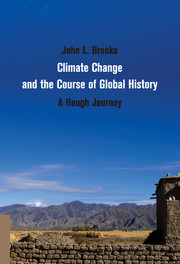Book contents
- Frontmatter
- Dedication
- Contents
- List of Figures and Tables
- Acknowledgments
- List of Abbreviations
- Introduction
- Part I Evolution and Earth Systems
- Part II Domestication, Agriculture, and the Rise of the State
- Part III Ancient and Medieval Agrarian Societies
- 6 Stasis and Growth in the Epoch of Agrarian Empires
- 7 Optimum and Crisis in Early Civilizations, 3000–500 BC
- 8 A Global Antiquity, 500 BC–AD 542
- 9 The Global Dark and Middle Ages, AD 542–1350
- Part IV Into the Modern Condition
- Data Bibliography: Full Citations for Data Used in Figures and Tables
- Index
- References
7 - Optimum and Crisis in Early Civilizations, 3000–500 BC
Published online by Cambridge University Press: 05 August 2014
- Frontmatter
- Dedication
- Contents
- List of Figures and Tables
- Acknowledgments
- List of Abbreviations
- Introduction
- Part I Evolution and Earth Systems
- Part II Domestication, Agriculture, and the Rise of the State
- Part III Ancient and Medieval Agrarian Societies
- 6 Stasis and Growth in the Epoch of Agrarian Empires
- 7 Optimum and Crisis in Early Civilizations, 3000–500 BC
- 8 A Global Antiquity, 500 BC–AD 542
- 9 The Global Dark and Middle Ages, AD 542–1350
- Part IV Into the Modern Condition
- Data Bibliography: Full Citations for Data Used in Figures and Tables
- Index
- References
Summary
The two and a half millennia from 3000 BC to 500 BC, one half of recorded human history, can be described in terms of a long global climatic optimum – and another global climatic crisis driven by a Hallstatt solar minimum. During this enormous span of time, and despite their apparent diversity, world cultures marched in generally common patterns, striking in their evolutionary similarities. Many of these similarities were shaped by a common global experience of long stretches of relatively stable climate optimum – and then roughly simultaneous abrupt climate change. If New World societies did not develop agriculture – and epidemic diseases – at quite the same pace as did those in the Old World, the pulse of the global Bronze Age optimum and then the Preclassical Crisis moved global societies along surprisingly similar tracks.
The Old World Bronze Age: Expansions and Crises, 3000–1000 BC
The Bronze Age encompassed at least the first two millennia of urban civilization in the Old World. During this long sweep of time, Old World societies in the Middle East, the eastern Mediterranean, India, and China developed amazingly enduring patterns of power and economy. With the apparent exception of Harappan India, these were societies of strict hierarchy, based on concepts of sacred kingship. Here the priests did not speak in the temple with the gods in the name and interest of the people; the king became a god and was the focal point of all things. Rather than evolving and changing, the Bronze Age systems simply intensified, becoming ever more elaborated and involuted. Their fate was in great measure decided by their environmental context. In India, a slow fading of the monsoons would equally slowly undermine the Harappan cities, as their peoples gradually abandoned them for a dispersed village life. In China, where a great crisis of flooding forged the beginnings of an early state, a broadly stable structure of the monsoon regime meant that the essential form of the Bronze Age polity would endure to the dawn of modernity.
- Type
- Chapter
- Information
- Climate Change and the Course of Global HistoryA Rough Journey, pp. 288 - 316Publisher: Cambridge University PressPrint publication year: 2014
References
- 1
- Cited by



